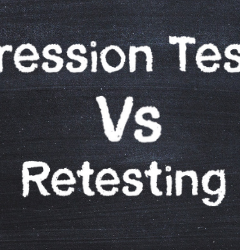Difference
QA Cost Comparison: Manual vs. Automated Testing – Maximizing Efficiency
- By Nikhil Trivedi
- No Comments
18 Oct

Introduction
Quality Assurance (QA) plays a crucial role in software development, ensuring that applications meet their intended standards of functionality, performance, and reliability. However, the choice between manual and automated testing methods can significantly impact the cost and efficiency of QA processes. In this blog post, we will explore the factors that affect the costs of manual and Automated Testing and how making the right choice can optimize your QA cost.
Understanding Manual Testing
Manual testing is the traditional method of QA, where human testers follow test cases to identify defects and issues in the software. While it offers several advantages, such as adaptability and human intuition, it can be time-consuming and costly.
- Resource Costs: Manual testing requires a team of skilled testers, leading to higher labor costs. These testers must be trained and often work on fixed schedules, contributing to increased costs.
- Time-Consuming: Manual testing is time-intensive, as testers need to execute repetitive test cases and scenarios, which can delay the development process.
- Human Error: Despite their expertise, human testers are prone to errors, potentially leading to overlooked defects.
Understanding Automated Testing
Automated testing, on the other hand, relies on software tools and scripts to execute test cases. While it requires an initial investment in automation setup, it offers substantial long-term benefits.
- Initial Setup Costs: Developing and maintaining automated tests can be costly initially, as it requires skilled automation engineers and the creation of test scripts.
- Reusability: Automated tests can be reused across different phases of the development cycle, reducing costs over time.
- Speed and Efficiency: Automated tests can be executed much faster and repeatedly, helping to identify defects early in the development process.
Comparing Manual and Automated Testing Costs
To understand the cost implications of manual vs. automated testing, we must consider the entire software development lifecycle. Let’s delve into the key aspects that influence the costs of these two testing approaches:
Labor Costs:
- Manual Testing: Requires a dedicated team of testers, leading to higher labor costs.
- Automated Testing: Requires skilled automation engineers but reduces labor costs in the long run due to test script reusability.
Test Case Maintenance:
- Manual Testing: Test cases need continuous updates as the software evolves, increasing maintenance costs.
- Automated Testing: Initial script creation and maintenance are necessary but provide long-term cost savings through reuse.
Testing Frequency:
- Manual Testing: Limited by the number of testers and their availability, making it time-consuming.
- Automated Testing: Can be run as often as needed, reducing time and overall costs.
Test Coverage:
- Manual Testing: Highly dependent on tester expertise and attention to detail.
- Automated Testing: Ensures comprehensive test coverage, reducing the risk of defects.
Regression Testing:
- Manual Testing: Time-consuming for repeated testing.
- Automated Testing: Efficiently handles regression testing, saving time and effort.
Human Error:
- Manual Testing: Prone to human errors that can lead to missed defects.
- Automated Testing: Offers consistency and precision, reducing the risk of human error.
Maximizing QA Efficiency and Minimizing Costs
To optimize QA costs, many organizations choose a hybrid approach, combining both manual and automated testing methods. Here’s how you can strike the right balance:
Strategic Test Selection: Identify critical areas of your application for automated testing, such as regression tests and repetitive tasks. Reserve manual testing for exploratory, usability, and ad-hoc scenarios.
Continuous Training: Invest in training your QA team to adapt to automated testing tools and methodologies, allowing them to work more efficiently.
Test Automation Frameworks: Use test automation frameworks that facilitate script creation and maintenance, reducing the overall cost of automation.
Regular Review: Continuously assess your testing strategy to ensure it aligns with the evolving needs of your project. Adjust the balance between manual and automated testing as required.
Conclusion
Software Testing Price management is a critical aspect of software development, and choosing the right testing approach can significantly impact your bottom line. Manual testing is valuable for its adaptability and human insight, while automated testing offers efficiency and accuracy. By striking a balance between the two and leveraging the strengths of each, you can maximize QA efficiency and reduce overall costs. So, keep your eye on the QA cost and choose the approach that best suits your project’s needs to ensure the highest quality software within your budget. At QACraft, we understand the importance of making this choice wisely to optimize your QA strategy and reduce costs effectively.
Nikhil works as a QA EngineerQACraft. Holding Diploma in Electronics engineering. He has 1+ years of experience in manual testing. Currently, he is upgrading his skills in automation testing. In his free time, he loves to travel and expanding technical skills.
Related Post
Leave a Comment Cancel reply
Categories
- Agile Testing
- Alpha Testing
- Android App Testing
- API Testing
- Automation Testing
- Banking Domain Testing
- Beta Testing
- cloud testing
- Corporate Life
- cross browser testing
- Cypress Testing
- desktop testing
- Difference
- Domain Testing
- E-commerce Website Testing
- E-learning App Testing
- End-To-End Testing
- Functional Testing
- Game Testing
- Healthcare Domain Testing
- Integration Testing
- Interview Questions
- ios App Testing
- Jenkins
- JIRA
- Katalon
- Manual Testing
- Mobile App Testing
- Monkey Testing
- Non-Functional testing
- Performance Testing
- Postman
- Regression Testing
- Salesforce Testing
- Sanity Testing
- security testing
- Selenium Testing
- Smoke Testing
- Software Testing
- Static Testing
- Test Case
- Test Environments
- Test Scenario
- Test Script
- TestRigor
- Web Application Testing
© Copyright 2025 QACraft Pvt. Ltd. All rights reserved.
Contact : +91 9157786796




Nikhil Trivedi